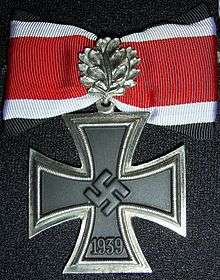Hans-Joachim Jabs
| Hans-Joachim Jabs | |
|---|---|
|
Hans-Joachim Jabs | |
| Born |
14 November 1917 Lübeck |
| Died |
26 October 2003 (aged 85) Lüdenscheid |
| Allegiance |
|
| Service/branch |
|
| Years of service | 1936–45 |
| Rank | Oberstleutnant |
| Unit | ZG 76 and NJG 1 |
| Commands held | Nachtjagdgeschwader 1 |
| Battles/wars |
|
| Awards | Ritterkreuz mit Eichenlaub |
| Other work | businessman |
Hans-Joachim Jabs (14 November 1917 – 26 October 2003) was both a day and night fighter ace[Note 1] in the German Luftwaffe during World War II. 50 victories[Note 2] were scored. Jabs flew variants of the Messerschmitt Bf 110 Zerstörer heavy day fighter and night fighter.
Biography
Born in Lübeck in 1917, Jabs joined the Luftwaffe in 1937. Originally trained as a Messerschmitt Bf 109 pilot, Jabs was posted to Zerstörergeschwader 76 (ZG 76), flying the Messerschmitt Bf 110, in March 1940.
A member of II./ZG 76, Jabs operated over France in mid 1940, claiming four French aircraft and RAF fighters. He then flew over the British Isles during the Battle of Britain. Despite the vulnerability of the Bf 110 against the more nimble Royal Air Force (RAF) aircraft, and the heavy losses incurred, Jabs claimed eight Spitfires and four Hurricanes destroyed. By the end of the year Jabs was one of the top scoring Zestörer (destroyer) pilots, with 16 victories.
In 1941 the majority of the Bf 110 units were withdrawn from daylight fighting, and Jabs was transferred to night fighting and Defense of the Reich. Retrained by October 1941, Jabs joined Nachtjagdgeschwader 3 stationed near Hamburg, protecting the port and Kriegsmarine installations. Opportunities for scoring remained elusive however, with just one more kill by June 1942. In November 1942 he transferred to IV./NJG 1. By January 1944 he had 45 kills to his credit, and in March 1944 became NJG 1 Geschwaderkommodore.
On 29 April 1944 his Bf 110-G night fighter was caught on a daylight air test by a flight of six Spitfires from No. 132 Squadron RAF, led by Squadron Leader Geoffrey Page (an ace with 15 kills). The Spitfires came in at too high a speed and Jabs shot down one Spitfire, flown by P/O R. B. Pullin, which went down in flames, killing the pilot. Another Spitfire flown by F/O J.J. Caulton then attacked Jabs head on, though the heavy forward armament of the 110 took effect and the stricken Spitfire glided around and belly-landed onto Deelen Air Base. Jabs then conducted a surprise forced landing, quickly scrambling for cover before his aircraft was destroyed by strafing.
Hans-Joachim Jabs was awarded the Knight's Cross of the Iron Cross with Oak Leaves (Eichenlaub zum Ritterkreuz des Eisernen Kreuzes) on 24 March 1944. He remained Kommodore of Nachjagdgeschwader 1 until the end of the war. He ended his career as an Oberstleutnant with 50 kills to his credit, 22 of these being day victories against Allied fighters technically far superior to his Bf 110. Jabs flew a total of 710 missions.[1]
Jabs became a businessman in Westphalia after the war. He was a vice-president of the Gemeinschaft der Jagdflieger.[1]
Awards
- Iron Cross (1939)
- Ehrenpokal der Luftwaffe on 29 March 1943 as Hauptmann and Staffelkapitän[3][Note 3]
- German Cross in Gold on 31 August 1943 as Hauptmann in the 11./NJG 1[5]
- Knight's Cross of the Iron Cross with Oak Leaves
- Knight's Cross on 1 October 1940 as Oberleutnant and pilot in the 2./ZG 76[6]
- 430th Oak Leaves on 24 March 1944 as Hauptmann and Gruppenkommandeur of the IV./NJG 1[6]
Notes
- ↑ For a list of Luftwaffe night fighter aces see List of German World War II night fighter aces
- ↑ 28 victories at night against Royal Air Force bombers including the Stirling (10), Wellington (1), Halifax (7) and Lancaster (10)
- ↑ According to Obermaier on 23 March 1943.[4]
References
Citations
Bibliography
- Drewes, Martin (2002). Sombras da noite. Rio de Janeiro: Adler Editora. ISBN 85-89015-02-5.
- Fellgiebel, Walther-Peer (2000) [1986]. Die Träger des Ritterkreuzes des Eisernen Kreuzes 1939–1945 — Die Inhaber der höchsten Auszeichnung des Zweiten Weltkrieges aller Wehrmachtteile [The Bearers of the Knight's Cross of the Iron Cross 1939–1945 — The Owners of the Highest Award of the Second World War of all Wehrmacht Branches] (in German). Friedberg, Germany: Podzun-Pallas. ISBN 978-3-7909-0284-6.
- Obermaier, Ernst (1989). Die Ritterkreuzträger der Luftwaffe Jagdflieger 1939 – 1945 [The Knight's Cross Bearers of the Luftwaffe Fighter Force 1939 – 1945] (in German). Mainz, Germany: Verlag Dieter Hoffmann. ISBN 978-3-87341-065-7.
- Patzwall, Klaus D.; Scherzer, Veit (2001). Das Deutsche Kreuz 1941 – 1945 Geschichte und Inhaber Band II [The German Cross 1941 – 1945 History and Recipients Volume 2] (in German). Norderstedt, Germany: Verlag Klaus D. Patzwall. ISBN 978-3-931533-45-8.
- Patzwall, Klaus D. (2008). Der Ehrenpokal für besondere Leistung im Luftkrieg [The Honor Goblet for Outstanding Achievement in the Air War] (in German). Norderstedt, Germany: Verlag Klaus D. Patzwall. ISBN 978-3-931533-08-3.
- Scherzer, Veit (2007). Die Ritterkreuzträger 1939–1945 Die Inhaber des Ritterkreuzes des Eisernen Kreuzes 1939 von Heer, Luftwaffe, Kriegsmarine, Waffen-SS, Volkssturm sowie mit Deutschland verbündeter Streitkräfte nach den Unterlagen des Bundesarchives [The Knight's Cross Bearers 1939–1945 The Holders of the Knight's Cross of the Iron Cross 1939 by Army, Air Force, Navy, Waffen-SS, Volkssturm and Allied Forces with Germany According to the Documents of the Federal Archives] (in German). Jena, Germany: Scherzers Militaer-Verlag. ISBN 978-3-938845-17-2.
- Thomas, Franz (1997). Die Eichenlaubträger 1939–1945 Band 1: A–K [The Oak Leaves Bearers 1939–1945 Volume 1: A–K] (in German). Osnabrück, Germany: Biblio-Verlag. ISBN 978-3-7648-2299-6.
- Toliver, Raymond & Constable, Trevor, 1979. Horrido!. Bantam Books.
- Williamson, Gordon (1989). Aces of the Reich. London: Arms and Armour. ISBN 0-85368-986-5.
| Military offices | ||
|---|---|---|
| Preceded by Oberst Werner Streib |
Commander of Nachtjagdgeschwader 1 March 1944 – 8 May 1945 |
Succeeded by none |

